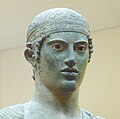Delphi Archaeological Museum
The Archaeological Museum Delphi ( Greek Αρχαιολογικό Μουσείο Δελφών Archeologiko Mousio Delfon ) is a museum in which archaeological finds from ancient Delphi are shown.
history
In Delphi excavations took place from 1892 under the direction of Greek and French archaeologists; the first museum was built in 1903. The plans came from Albert Tournaire , the sponsor and founder was Andreas Syngros . In 1935/36 the two-wing building was expanded and renovated. In 1956 a room for inscriptions was added. A fundamental renovation was carried out in 1958 according to plans by the Greek architect Patroklos Karantinos . As part of this renovation, a room for the charioteer of Delphi and one for bronze objects were added. In the 1960s, the exhibition concept was revised again; From the later 1970s and again in 1999, further alterations and redesigns took place.
The museum is located in the immediate vicinity of the excavation site and now has 14 exhibition rooms.
Exhibits
The most famous pieces include the archaic statues of the brothers Kleobis and Biton , the Sphinx of the Naxians and the charioteer of Delphi as well as an omphalos , which originally stood to mark the center of the earth at the temple of Apollo . An Antinous statue and various portraits date from Roman times , including the head of the "melancholy Roman", which is sometimes interpreted as a representation of Titus Quinctius Flamininus .
Also worth seeing are ivory carvings and relief gold appliqués from the 7th and 6th centuries BC, including two impressive archaic heads from gold and ivory statues, possibly Apollo and Artemis, as well as the remains of a life-size representation of a bull made from embossed silver sheet. These were found in a sacrificial pit in 1939, but were hidden in the magazines for decades.
literature
- * Lambert Schneider , Christoph Höcker : Mainland Greece. Antiquity and Byzantium, Islam and Classicism between the Corinthian Gulf and northern Greek mountains (= DuMont Art Travel Guide ). 5th edition. Dumont Reiseverlag, Ostfildern 2011, ISBN 978-3-7701-2936-2 , p. 247 ff.
Web links
Remarks
- ↑ Delphi Archaeological Museum, Greek Ministry of Culture (English)
- ↑ Lambert Schneider , Christoph Höcker : Greek mainland. Antiquity and Byzantium, Islam and Classicism between the Corinthian Gulf and northern Greek mountains (= DuMont Art Travel Guide ). 5th edition. Dumont Reiseverlag, Ostfildern 2011, ISBN 978-3-7701-2936-2 , p. 247 ff.
Coordinates: 38 ° 28 ′ 49.1 ″ N , 22 ° 29 ′ 59.4 ″ E






